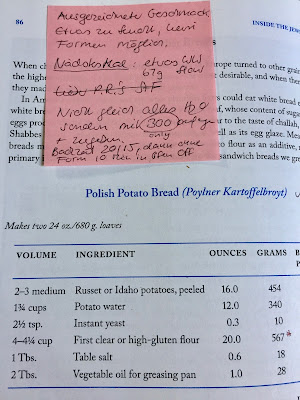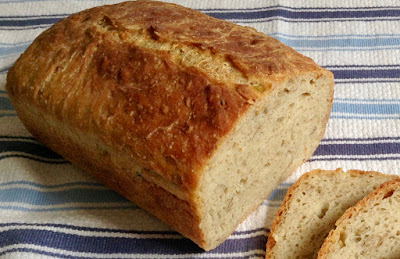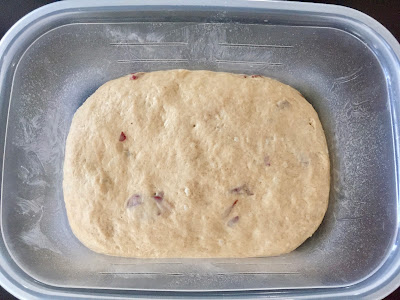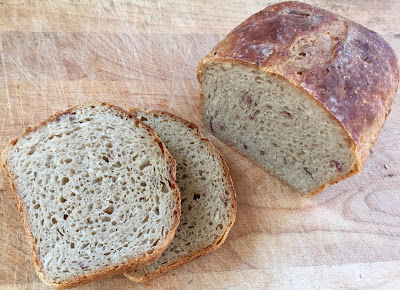Whenever I'm visiting my hometown Hamburg, I check out new bakeries. Two years ago I noticed people lining up in front of Bäckerei Jochen Gaues, in Eppendorf quarter, where my Mom lives around the corner.
Taking this as a good omen, I joined the waiting line. The shelves full of loaves and rolls looked promising, all with fairly dark crusts - boldly baked, as Ken Forkish ("Flour, Water, Salt and Yeast') would call it. A paradise for crust lovers!
Like Forkish, Jochen Gaues is a purist baker, his breads are made with flour, water, salt and yeast. No dough enhancers, no preservatives, no artificial flavoring. Only sourdough and passion for his craft. And he shared his recipes in a beautiful baking book, too.
His sunflower seed rolls are hearty, crusty and delicious. (I tweaked the recipe a bit, of course, as I always do). The crumb is rather light and more airy than chewy. You can enjoy them with cold cuts, German meat salad, honey or jam.
 |
| The rolls have a thin, crisp crust and a somewhat airy crumb |
SUNFLOWER SEED SQUARES (adapted from Jochen Gaues' "Brot")
(8 square rolls)
Starter
10 g/0.3 oz recently refreshed rye mother starter (100%)
10 g/0.4 oz water, lukewarm
10 g/0.4 oz rye flour
Soaker
25 g/0.9 oz cracked rye
25 g/0.9 oz flaxseed
50 g/1.8 oz water
Final dough
30 g/1.1 oz starter (all)
367 g/12.9 oz water (95°F/35ºC)
3 g/0.1 oz instant yeast
475 g/15.8 oz bread flour
50 g/1.8 oz old sourdough bread, ground and toasted
25 g/0.9 oz medium rye flour
25 g/0.9 oz sunflower seeds, toasted
14 g/0.5 oz sugar
14 g/0.5 oz salt
egg white, mixed with a little bit of water, for brushing
sunflower seeds, for topping
 |
| Seed soaker and rye starter |
DAY 1
In the morning, mix starter ingredients in small bowl. Leave, covered, at room temperature for 4 - 6 hours, or until it passes the float test (a teaspoonful should float in water).
In second small bowl, stir together soaker ingredients. (This extra step is not absolutely necessary, but hard ingredients like rye chops and flax seeds benefit from longer soaking.)
In the afternoon, mix final dough at low speed until all flour is hydrated, 1 - 2 minutes. Let dough rest 5 minutes, then knead at medium-low speed for 6 minutes. Dough will be soft and sticky, but pull back from sides of bowl.
 |
| Dough will be sticky, but pull back from sides of bowl |
Transfer dough to lightly oiled work surface. With oiled hands, pat and pull it into a rough square. Fold dough from top and bottom in thirds, like a business letter, then the same way from both sides.
 |
| Pat and pull dough into a square... |
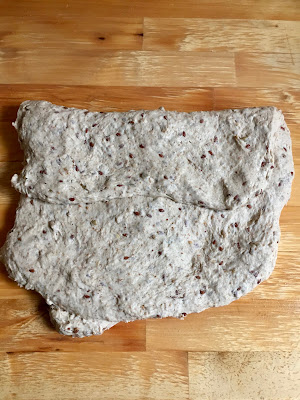 |
| ...then fold in thirds, top down, and bottom up... |
 |
| ...like a business letter. |
 |
| Repeat folding from both sides... |
 |
| ... until you have a neat package |
Cover dough package with the empty mixing bowl (if necessary, re-oil works bench). Let it rest for 10 minutes.
Repeat stretching and folding the dough 3 more times, at 10 minute intervals. It will gain strength and starting to resist. Place dough in oiled container, cover, and refrigerate overnight (a square container helps with shaping later).
 |
| Before... |
 | |
| ...and after fermentation: it has doubled in volume |
DAY 2
Remove dough from fridge 2 hours before using. It should have doubled in volume.
Preheat oven to 475ºF/240ºC (no steam).
Place dough on a lightly floured work surface, sprinkle with a little flour (it will still be a bit sticky), and gently pull and pat it into a rectangle, then cut into 8 square pieces. Place squares on parchment lined (or perforated) baking sheet.
 |
| The rolls are cut, not shaped |
Brush rolls with egg white, then sprinkle each with sunflower seeds, gently pressing them down to stick. Cover, and proof for about 25 - 30 minutes, or until a finger-poked dimple remains visible. (Since the dough is cut, not shaped, it is puffy and doesn't need to rise much more - basically only until the oven is hot).
 |
| Ready for the oven |
Bake rolls for about 20 minutes (rotating them halfway through), or until they are a dark golden brown, and register at least 200ºF/93ºC on an instant read thermometer.
 |
| Freshly baked Sunflower Seed Squares |
BreadStorm users (also of the free version) can download the formula here.


